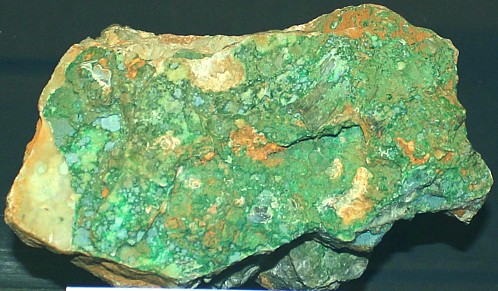|
.
Garnierite
Mineral Facts:
Chemical
Formula: Ni2Mg2Si3O10.6H2O
Garnierite
may be regarded as a serpentine or talc in which a portion of the magnesium
has been replaced by nickel. Variable and uncertain composition, not
recognized as an individual mineral species.
Colors:
Pale green
to dark green.
Hardness:
3
to 4
Hardness is variable based on porosity.
Density:
2.2 to 2.8
Cleavage:
None.
Crystallography:
Amorphous
Occurs principally
in the form of amorphous slightly botryoidal masses compact or soft
and earthy crusts.
Luster:.
Earthy and dull luster.
|

Garnierite Nickel ore |
|
Composition, Structure and
Associated Minerals:
Garnierite
occurs as earthy masses, as mamillary coatings and as impregnations and
veins in serpentine as well as crusts in
laterites and saprolites derived from the deep
weathering of ultra basic rocks. In all cases it
appears to be a secondary mineral resulting from the weathering of
peridotite. The earthy masses are residual and the veins are deposits from
downward percolating water that obtained nickel from the decomposing rock.
Identification
and Diagnostics
Composition variable, but
essentially a hydrated silicate of magnesium and nickel, containing up to 30
per cent nickel. Infusible in the blow pipe flame. Blackens and gives off
much water in closed tube. Gives strong Nickel
color the borax
bead reactions. Becomes magnetic
after heating in blowpipe flame on charcoal.
It is partly soluble in HC1 and
HN03. Difficultly decomposed by hydrochloric acid, giving separated silica., but does not yield gelatinous
silica.
It is readily distinguished from
malachite and
chrysocolla by its structure, its greasy feel and the absence of a
positive copper test.
Localities
The found with
chromite at Texas, Lancaster County, Pennsylvania. Garnierite occurs in
considerable amount, associated with serpentine and chromite, near Noumea,
New Caledonia.
In New Caledonia, notably in the
Thio district on the east side of the island, nickel ore occurs abundantly
in serpentine which has been formed by the alteration of intrusive
peridotites. The ore mineral is garnierite, occurring as veins and
concretionary masses in the serpentine. The unaltered olivine rock contains
nickel, usually in small amounts, though specimens have been found
containing as much as 2.5 per cent, of nickel. The richer garnierite of the
veins contains from 20 to 45 per cent, of nickel oxide, but the ore for the
most part is much poorer than this. Still, the deposits on the
plateaus of New Caledonia are a classic laterite nickel deposit in its
composition. It comprises
limonite iron oxides on the surface (laterites) and magnesium silicates
beneath (saprolite). The nickel and cobalt contained in these deposits from
chemical concentration through residual processes. Of the many laterite
deposits across the world, this has one of the highest nickel contents.The
ore is obtained in surface quarries, and as produced contains on the average
not more than six or seven per cent, of nickel. It is in part smelted
locally to obtain a rich matte.
The ultimate product of weathering of the serpentine in New Caledonia is a
red lateritic clay and much of this is associated with the nickel ore.
Garnierite deposits closely resembling those of New Caledonia are found at
Port Macquarie in New South Wales, Australia and
at various localities in Madagascar.
In the US,
garnierite a has been mined as a source of nickel at Riddle, Douglas Co.,
Oregon. Garnierite occurs associated with chromite in serpentine at Texas,
Lancaster Co., Penn., at Webster, N. C., at Malaga, in Spain, and at a few
other places.
Industrial Uses of
Graphite
Garnierite
serves as an important ore of nickel. I has been produced
from a number of mines around the world.
.Return
to the
Mineral Collectors Information Page |
|


